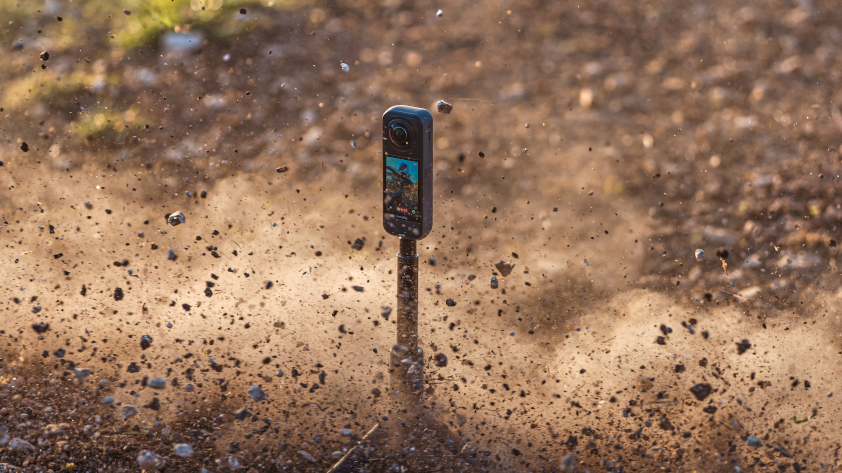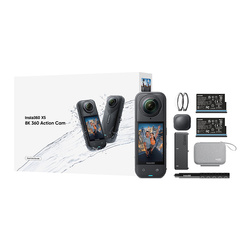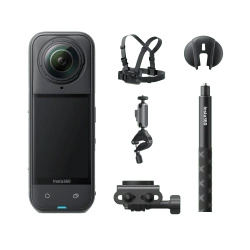Beyond the Edge of Innovation: An Interview with Insta360’s Product Manager

Since their inception, 360° cameras have tiptoed along the edge of a revolution—pushing it farther and farther. Technical limits like poor low-light performance, fragile lenses, and time-consuming editing have held creators back and caused real frustration. With the launch of the Insta360 X5, those barriers are broken. It’s the most advanced camera of its kind on the market.
In this exclusive interview, Robin (Product Manager at Insta360) reveals how the X5 was engineered to give creators new possibilities—and why it was designed that way. Learn how our R&D team built state-of-the-art hardware to tackle the toughest challenges, helping creators capture, edit, and publish their best clips more easily than ever.
Market challenge accepted: what sets Insta360 X5 apart
What had been slowing down the 360 camera industry before the X5—and how did Insta360 solve it?
The truth is, 360 cameras have kept evolving for years, but we kept hearing the same pain points from users: poor image quality at night, cracked/scratched lenses, and editing that felt too hard. These weren’t minor complaints—they were the main reasons people hesitated to buy a 360 camera. So when we started work on the Insta360 X5, our goal was to take those problems head-on—and solve them. For good.
We didn’t just update the previous model (X4). We rethought the entire 360 experience—from shooting to editing to sharing. We significantly improved low-light results, built a lens that’s twice as durable as before, and introduced AI-powered tools that make editing easier than it’s ever been.
We didn’t want to make just a “better” camera; we set out to create a camera you can trust to capture every moment beautifully—no matter the lighting, environment, or your level of experience.
Tell us more about low-light filming. Why was it so important for the X5?
Low light has been the Achilles’ heel of all action cameras—including 360 cams. You wanted to capture a magical night walk or a city skyline glittering after dark, but the results fell short. We set out to change that. That’s why the X5 is packed with exceptional solutions, both in hardware and in brand-new software. Two powerful 1/1.28" sensors give the X5 outstanding clarity and better performance in low light. For comparison: each pixel has 132% more light-sensitive surface area than on the X4, which means the X5 captures that much more detail—especially in challenging lighting.
To capture every angle at once, a 360° camera uses two ultra-wide lenses. Processing all that data requires enormous compute. So the X5 uses a triple-processor design with AI, delivering 140% more performance. They work together: the first two Pro Imaging Chips handle the initial image pipeline—reducing noise, lifting brightness, and optimizing contrast. Then a dedicated 5 nm AI chip takes over, refining the data with deep-learning algorithms. Textures gain more detail and natural color. Each chip has its job so that, together, they produce images that are brighter, clearer, and more lifelike—especially in the dark.
Finally, there’s PureVideo, our new low-light video mode built specifically for the demands of 360° shooting in dim scenes. We didn’t just port a generic low-light mode from another camera—on X5 we built PureVideo from real user feedback and real footage from previous models. It delivers richer textures, improved sharpness, and scenes rendered the way your eyes see them—now in full 8K.
The X5 features Insta360’s most durable lenses. Why was lens toughness a priority?
We saw the same story too many times: even after a first fall, a lens gets scratched or cracked. Sometimes it’s inattention; sometimes it’s bad luck. For 360 creators—especially in extreme sports or remote locations—it’s more than an inconvenience. It can ruin an entire shoot, a trip, or a training camp.
So with the X5, lens durability became a top priority. We analyzed years of user feedback—repair reports, social comments, product returns. Lens damage came up again and again. Instead of another stopgap like an external lens guard, we decided to fix the root cause.
We reinforced the lens glass itself, testing dozens of materials for strength, clarity, and optical performance. The X5 lens is coated with an ultra-hard optical layer and built on a strengthened, impact-resistant structure that withstands drops we tested in real-world conditions. But what truly sets the X5 apart is its interchangeable lenses. Users can quickly swap them on the spot and keep shooting—no shipping the camera to a service center, no waiting.
We ran over 4,000 drop tests across 400+ devices. The result is a lens that’s twice as durable as the X4’s—without sacrificing image quality.
Editing and post-production have traditionally been a major pain point for video creators—especially with 360 cameras. How does the X5 help on that front?
We’ve always known the magic of 360 footage is the freedom to frame your shot after you shoot it. But that freedom can come at a cost: time. For many users, editing 360° content meant learning an entirely new software stack—overwhelming and, at times, frustrating. With the X5, creators get tools that make editing and finishing great videos faster and more intuitive than ever.
At the heart of this is InstaFrame, our brand-new shooting mode. It records a standard flat video and a spherical (360°) video simultaneously. That means you can share the standard clip immediately, then come back later to re-frame a new version—maximum flexibility.
Earlier this year we also launched Insta360+, a cloud subscription designed to simplify the entire workflow. Insta360+ makes it easy to store, manage, back up, and even edit 360° content in the cloud, on any device, wherever creators are.
I want to stress this: Insta360+ isn’t just “more features.” It’s a fundamentally new way to use the app. With the redesigned mobile app plus Insta360+, 360 editing is more intuitive, more accessible, and more efficient than ever. Whether you’re a beginner or a seasoned pro, with Insta360+ you’ll work faster and easier—and the results will look better than before.
What did users need, what was missing—and which innovations did you introduce to meet those expectations?
Which user problems did you diagnose, and how did you solve them in the X5?
From day one, our company has been led by our users’ needs. Their feedback sets the direction for our products and services. That approach has earned us millions of enthusiastic users worldwide; their input isn’t just a reference point—it’s the foundation of our development.
With the X4, we set new benchmarks for 360 action cams—introducing breakthrough specs like 8K resolution and higher frame rates. With the X5, we focused on solving and eliminating the problems users reported, rather than chasing a raw spec race.
We made this our top priority. We analyzed reviews, combed through social media, gathered direct feedback from a wide range of creators, and even leveraged insights from our suppliers. That helped us identify issues you can’t spot by looking at raw data alone. The X5 exists because of our users. We built it—but to a significant degree (I’d say predominantly), our users designed it. We simply met the expectations and fixed the problems they raised. Insta360 X5 is the work of our engineers, guided by millions of users. Thanks to them—and to you—the X5 is this good.
And it’s not just about listening—we’re users ourselves. Many of us at Insta360 are skiers, hikers, vloggers, and creators. We actively exchange notes with users and test the cameras in real-world scenarios, which helped us identify and understand problems first-hand.
Were there any specific insights that inspired the X5’s direction?
For the X5, we conducted over 100 in-depth conversations with users across profiles—from extreme athletes to travel vloggers and hobbyists. These talks gave us what data alone can’t: engagement and emotion.
We heard real stories: a rock climber who wanted to capture an early-morning ascent in faint dawn light; a mother who loved filming 360° memories of (and for) her kids but hated the long hours of editing—hours she simply doesn’t have. Stories like these helped us pinpoint the technical problems we needed to solve to deliver more satisfaction from the results: better low-light performance and a dramatic reduction in editing time unleash the emotional value for users like that climber and that mom.
How did Insta360 turn those insights into a new product?
Crucially, we don’t collect feedback only from behind a desk. Everyone working on a new product takes it into the field—skiing, hiking, fishing—testing every prototype in the same kinds of conditions our users face. That helps us spot issues early and feed those insights directly into development.
One colleague even earned a ski-instructor certification—not only out of personal passion, but to better understand the extreme-sports community from the inside. We believe that to design for users, you have to be a user. That’s how we build cameras at Insta360.
All creators—athletes, travelers, parents—face challenges shaped by their environments and habits. The only way to truly understand their needs is to step into their world. This mindset guides every Insta360 product, including the X5.
As the Insta360 X5 cements its position at the forefront of 360-camera innovation, it’s clear this is more than just an action cam—it’s a breakthrough tool for creators worldwide. We’re answering long-standing industry challenges with user-centric innovation. From outstanding low-light performance to durability and intuitive editing, the X5 was designed to make it easy for creators to capture every moment. And we’ve done it. The future of cameras just got a lot brighter.
Source: Insta360.com
Recommended

Insta360 X5

Insta360 X5 Essentials Bundle

